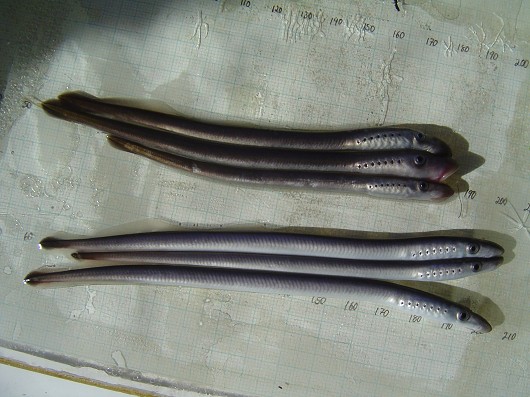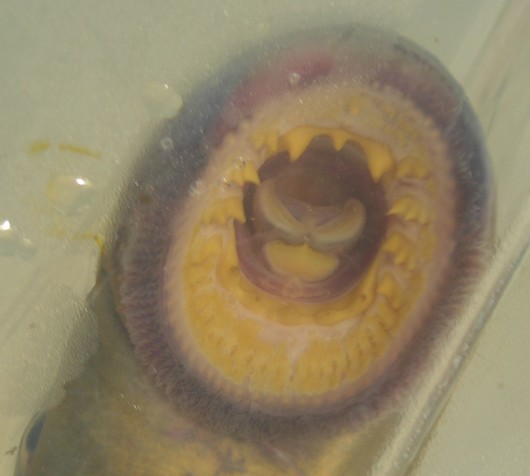Pacific Lamprey
-
Scientific NameLampetra tridentata
-
NativeNative Species
-
Identification
 Pacific lamprey, captured in rotary screw trap on Sacramento River at Knight's Landing. Photo by Dan Worth, California Department of Fish and Game.
Pacific lamprey, captured in rotary screw trap on Sacramento River at Knight's Landing. Photo by Dan Worth, California Department of Fish and Game. Pacific lamprey (mouth), captured in rotary screw trap on Sacramento River at Knight's Landing. Photo by Robert Vincik, California Department of Fish and Game.
Pacific lamprey (mouth), captured in rotary screw trap on Sacramento River at Knight's Landing. Photo by Robert Vincik, California Department of Fish and Game. Pacific lamprey juvenile (albino), captured in rotary screw trap on Sacramento River at Knight's Landing. Photo by Robert Vincik, California Department of Fish and Game.
Pacific lamprey juvenile (albino), captured in rotary screw trap on Sacramento River at Knight's Landing. Photo by Robert Vincik, California Department of Fish and Game.- Largest of CA lampreys, commonly exceed 40 cm TL, dwarfs exist
- Two dorsal fins, slightly separated, 2nd dorsal continuous with caudal fin
- Body segments (myomeres): 62-71
- Males: taller dorsal fins, anal fin absent, may possess small genital papillae
- Females: short dorsal fins, possess anal fin
- Larvae: 68-70 segments between anus and last gill opening, dark back and lower oral hood
- Newly morphed adults silvery in color
- Spawning adults: dark greenish black
- Oral disc 6-8% of TL
- Sucking disc full of horny plates
- Supraoral lamina has 1 small center cusp and 2 larger lateral cusps
- Inner lateral plates (4) on each side: middle 2 tricuspid, outer 2 bicuspid
- Tongue ends in 14-21 small points, center point largest
-
Life History
Pacific lampreys are usually anadromous with two very distinct parts of their life cycle, though some landlocked forms of lamprey exist. Pacific lampreys begin their life cycle as an ammocoete or larvae, usually within a freshwater stream. Ammocoetes burrow tail first into mud or soft substrate where they filter feed on algae and organic matter. The larval lampreys often move around the stream in their 5-7 year stay in freshwater. When the ammocoetes reach a length of around 14-16 cm TL they begin a drastic change in physiology and physical appearance. The larval lampreys take on a silvery form with large eyes and a sucking disc. The newly morphed lampreys swim downstream to the Pacific Ocean where they take on a new predatory lifestyle in an estuarine or saltwater environment. Lampreys rarely stray far from the mouth of their home stream. Pacific lampreys attack and feed on fish including salmon and flatfish. The stay at sea usually lasts 3-4 years in Canada but may be shortened in more southern populations. Like salmon, the lampreys return to freshwater and migrate upstream to spawn and die. Most upstream movement occurs during the night under high flow conditions, and some streams have different runs of lampreys. Runs may be different in the timing of entry to freshwater or in the amount of time spent in freshwater before breeding occurs. Breeding males and females dig a nest in moderately swift water by removing rock and gravel from the stream floor. A female will attach herself to a rock upstream of the nest, and the male will attach himself to the female or to a nearby anchor. The female releases 20,000 to 200,000 eggs in total, and the male releases his milt. The nest is then covered by stirring the substrate upstream of the fertilized eggs. Often one female will have her eggs fertilized by multiple males, as individual nests may be constructed in close proximity to others. Usually the male and female then die, though studies have shown that some adult lampreys live to spawn again the following year. The embryos hatch after roughly 19 days, and the resulting ammocoetes often stay within the safety of the gravel substrate before venturing into the current.
-
Links to Other ResearchN / A
-
Watershed
-
Alisal-Elkhorn Sloughs Watershed
-
Applegate Watershed
-
Big-Navarro-Garcia Watershed
-
Bodega Bay Watershed
-
Butte Watershed
-
Calleguas Watershed
-
Carmel Watershed
-
Central Coastal Watershed
-
Chetco Watershed
-
Cottonwood Headwaters Watershed
-
Coyote Watershed
-
Cuyama Watershed
-
Estrella Watershed
-
Goose Lake Watershed
-
Gualala-Salmon Watershed
-
Honcut Headwaters Watershed
-
Illinois Watershed
-
Los Angeles Watershed
-
Lost Watershed
-
Lower American Watershed
-
Lower Bear Watershed
-
Lower Butte
-
Lower Cache Watershed
-
Lower Calaveras-Mormon Slough Watershed
-
Lower Cosumnes-Lower Mokelumne Watershed
-
Lower Cottonwood Watershed
-
Lower Eel Watershed
-
Lower Feather Watershed
-
Lower Klamath Watershed
-
Lower Sacramento Watershed
-
Lower Yuba Watershed
-
Mad-Redwood Watershed
-
Mattole Watershed
-
Middle Fork Eel Watershed
-
Middle San Joaquin-Lower Chowchilla Watershed
-
Middle San Joaquin-Lower Merced-Lower Stanislaus Watershed
-
Mill Watershed
-
Mill-Big Chico Watershed
-
Pajaro Watershed
-
Russian Watershed
-
Sacramento-Lower Cow-Lower Clear Watershed
-
Sacramento-Lower Thomes Watershed
-
Sacramento-Stone Corral Watershed
-
Salinas Watershed
-
Salmon Watershed
-
San Antonio Watershed
-
San Diego Watershed
-
San Francisco Bay Watershed
-
San Francisco Coastal South Watershed
-
San Joaquin Delta Watershed
-
San Lorenzo-Soquel Watershed
-
San Pablo Bay Watershed
-
Santa Ana Watershed
-
Santa Barbara Coastal Watershed
-
Santa Clara Watershed
-
Santa Margarita Watershed
-
Santa Maria Watershed
-
Santa Monica Bay Watershed
-
Santa Ynez Watershed
-
Scott Watershed
-
Seal Beach Watershed
-
Shasta Watershed
-
Smith Watershed
-
South Fork Eel Watershed
-
South Fork Trinity Watershed
-
Suisun Bay Watershed
-
Tomales-Drake Bays Watershed
-
Trinity Watershed
-
Upper Butte
-
Upper Cache Watershed
-
Upper Coon-Upper Auburn Watershed
-
Upper Cosumnes Watershed
-
Upper Cow-Battle Watershed
-
Upper Eel Watershed
-
Upper Elder-Upper Thomes Watershed
-
Upper Klamath Watershed
-
Ventura Watershed
-
Please note, watersheds are at the USGS 8-digit Hydrologic Unit Code (HUC) scale, so they often include a lot of sub-watersheds. If a species occurs in any sub-watershed within the HUC, the species appears within the HUC. Link to an EPA page that shows HUCs.


